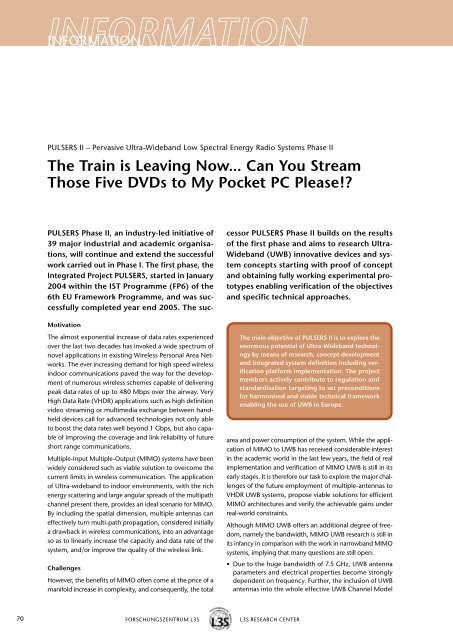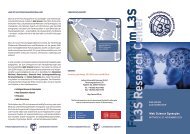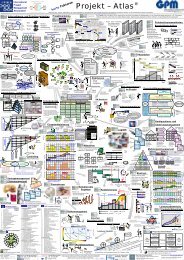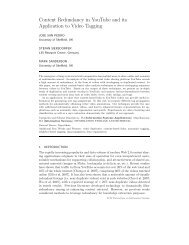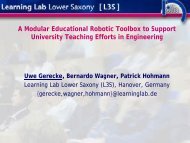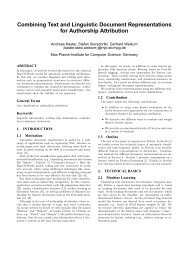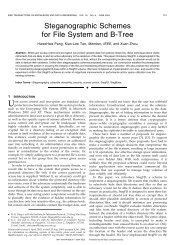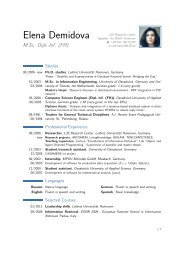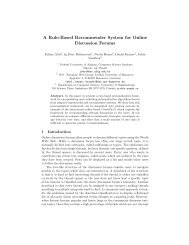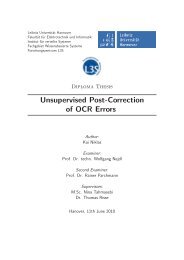knowledge · information · learning - Forschungszentrum L3S
knowledge · information · learning - Forschungszentrum L3S
knowledge · information · learning - Forschungszentrum L3S
You also want an ePaper? Increase the reach of your titles
YUMPU automatically turns print PDFs into web optimized ePapers that Google loves.
70<br />
INFORMATION<br />
PULSERS II – Pervasive Ultra-Wideband Low Spectral Energy Radio Systems Phase II<br />
The Train is Leaving Now... Can You Stream<br />
Those Five DvDs to My Pocket PC Please!?<br />
PuLSERS Phase II, an industry-led initiative of<br />
39 major industrial and academic organisations,<br />
will continue and extend the successful<br />
work carried out in Phase I. The first phase, the<br />
Integrated Project PuLSERS, started in january<br />
2004 within the IST Programme (FP6) of the<br />
6th Eu Framework Programme, and was successfully<br />
completed year end 2005. The suc-<br />
Motivation<br />
The almost exponential increase of data rates experienced<br />
over the last two decades has invoked a wide spectrum of<br />
novel applications in existing Wireless Personal Area Networks.<br />
The ever increasing demand for high speed wireless<br />
indoor communications paved the way for the development<br />
of numerous wireless schemes capable of delivering<br />
peak data rates of up to 480 Mbps over the airway. Very<br />
High Data Rate (VHDR) applications such as high definition<br />
video streaming or multimedia exchange between handheld<br />
devices call for advanced technologies not only able<br />
to boost the data rates well beyond 1 Gbps, but also capable<br />
of improving the coverage and link reliability of future<br />
short range communications.<br />
Multiple-Input Multiple-Output (MIMO) systems have been<br />
widely considered such as viable solution to overcome the<br />
current limits in wireless communication. The application<br />
of Ultra-wideband to indoor environments, with the rich<br />
energy scattering and large angular spreads of the multipath<br />
channel present there, provides an ideal scenario for MIMO.<br />
By including the spatial dimension, multiple antennas can<br />
effectively turn multi-path propagation, considered initially<br />
a drawback in wireless communications, into an advantage<br />
so as to linearly increase the capacity and data rate of the<br />
system, and/or improve the quality of the wireless link.<br />
Challenges<br />
However, the benefits of MIMO often come at the price of a<br />
manifold increase in complexity, and consequently, the total<br />
FORSCHUNGSZENTRUM <strong>L3S</strong> <strong>L3S</strong> RESEARCH CENTER<br />
cessor PuLSERS Phase II builds on the results<br />
of the first phase and aims to research ultra-<br />
Wideband (uWB) innovative devices and system<br />
concepts starting with proof of concept<br />
and obtaining fully working experimental prototypes<br />
enabling verification of the objectives<br />
and specific technical approaches.<br />
The main objective of PuLSERS II is to explore the<br />
enormous potential of ultra-Wideband technology<br />
by means of research, concept development<br />
and integrated system definition including verification<br />
platform implementation. The project<br />
members actively contribute to regulation and<br />
standardisation targeting to set preconditions<br />
for harmonised and viable technical framework<br />
enabling the use of uWB in Europe.<br />
area and power consumption of the system. While the application<br />
of MIMO to UWB has received considerable interest<br />
in the academic world in the last few years, the field of real<br />
implementation and verification of MIMO UWB is still in its<br />
early stages. It is therefore our task to explore the major challenges<br />
of the future employment of multiple-antennas to<br />
VHDR UWB systems, propose viable solutions for efficient<br />
MIMO architectures and verify the achievable gains under<br />
real-world constraints.<br />
Although MIMO UWB offers an additional degree of freedom,<br />
namely the bandwidth, MIMO UWB research is still in<br />
its infancy in comparison with the work in narrowband MIMO<br />
systems, implying that many questions are still open:<br />
• Due to the huge bandwidth of 7.5 GHz, UWB antenna<br />
parameters and electrical properties become strongly<br />
dependent on frequency. Further, the inclusion of UWB<br />
antennas into the whole effective UWB Channel Model


